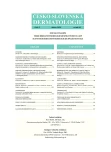Rosacea Fulminans
Authors:
K. Lednová; V. Vašků; H. Jedličková
Authors‘ workplace:
I. dermatovenerologická klinika FN U sv. Anny v Brně a LF MU
přednosta doc. MUDr. Vladimír Vašků, CSc.
; Dermatovenerologické oddělení Fakultní nemocnice v Motole
prim. MUDr. Alena Machovcová, MBA
Published in:
Čes-slov Derm, 85, 2010, No. 2, p. 99-103
Category:
Case Reports
Overview
Rosacea fulminans (syn. pyoderma faciale) is a rare disease of unknown etiology affecting exclusively women between 30 and 40 years of age, often with rapid onset. Clinical symptoms include papules, pustules, confluent nodules and abscesses. Constitutional symptoms are usually absent. A case of 37-year-old woman with a form of facial pyoderma is described. Previous outpatient therapy had no effect. The patient was treated with isotretinoin and metronidazol with a very good clinical effect. The treatment success was based on the correct diagnosis, identification and elimination of triggering factors.
Key words:
rosacea fulminans – pyoderma faciale – isotretinoin
Sources
1. BAMFORD, J., TILDEN, R., BLANKUSH, J., GANGENESS, D. Effect of treatment of Helicobacter pylori infection on rosacea. Arch Dermatol, 1999, 135, p. 659-663.
2. BAMFORD, J. Rosacea: Current thoughts on origin. Sem Cutan Med Surg, 2001, 20, p. 199-206.
3. BUECHNER, SA. Rosacea: An Update. Dermatology, 2005, 210, p. 100-108.
4. CRAWFORD, G., PELLE, M., JAMES, W. Rosacea. I. Etiology, pathogenesis, and subtype classification. J Am Acad Dermatol, 2004, 51, p. 327-341.
5. CUNLIFFE, WJ. Acne. London: Dunitz, 1989, p. 38-39.
6. ERDOGAN, F., YURTSEVER, P., AKSOY, D., ESKIOGLU, F. Efficacy of low-dose isotretinoin in patiens with treatment-resistant rosacea. Arch Dermatol, 1998, 134, p. 884-885.
7. ERTL, G., LEVINE, N., KLIGMAN, AA. Comparison of the efficacy of topical tretinoin and low-dose oral isotretinoin in rosacea. Arch Dermatol, 1994, 130, p. 319-324.
8. FERNANDEZ - OBREGON, A. Oral use of azithromycin for the treatment of acne rosacea. Arch Dermatol, 2004, 140, p. 489-490.
9. FORTON, F. Demodex et inflammation périfolliculaire chez l’homme: revue et observation de 69 biopsies. Ann dermatol Vénéréol, 1986, 113, p. 1047-1058.
10. GEORGALA, S., KATOULIS, A., KYLAFIS, G., KOUMANTAKI - MATHIOUDAKI, E., GEORGALA, C., ARONI, K. Increased density of Demodex folliculorum and evidence of delayed hypersensitivity reaction in subjects with papulopustular rosacea. J Eur Acad Dermatol Venereol, 2001, 15, p. 441 - 445.
11. HOFER, T. Continuous´microdose´isotretinoin in adult recalcitrant rosacea. Clin Exp Dermatol, 2004, 29, p. 204-205.
12. JANSEN, T., PLEWIG, G. Orale Behandlung der Rosazea mit Isotretinoin. Dtsch Med Wochenschr, 1995, 120, p. 1745-1747.
13. JANSEN, T., PLEWIG, G. Pathogenese der Rosazea: Fakten und Mythen. Z Hautkr, 1996, 71, p. 8-14.
14. JANSEN, T., PLEWIG, G. Rosacea: Classification and treatment. J R Soc Med, 1997, 90, p. 144-150.
15. MASSA, MC., SU, W. Pyoderma faciale: A clinical study of twenty-nine patiens. J Am Acad Dermatol 1982, 6, p. 84-91.
16. NIKOLOWSKI, J., PLEWIG, G. Orale Behandlung der Rosazea mit 13-cis-Retinsäure. Hautarzt, 1981, 32, p. 575-584.
17. O’LEARY, PA., KIERLAND, RR. Pyoderma faciale. Arch Dermatol Syphil, 1940, 41, p. 451-462.
18. PLEWIG, G., KLIGMAN, A. Acne and Rosacea, 2. ed Berlin: Springer, 1993, p. 164-166.
19. PLEWIG, G., JANSEN, T. Rosacea. In FREEDBERG, I., EISEN, A., WOLFF, K., AUSTEN, K., GOLDSMITH, L., KATZ, S. (eds). Fitzpatrick’s Dermatology in General Medicine. New York: McGraw-Hill, 2003, p. 688-696.
20. RAMELET, A. Rosacea: Disease or reaction pattern? Dermatologica, 1986, 173, p. 53-56.
21. RAMELET, AA., PERROULAZ, G. Rosacea: Histopathologic study of 75 cases. Ann Dermatol Vénéréol, 1988, 115, p. 801-806.
22. REBORA, A., DRAGO, F., PICCIOTTO, A. Helicobacter pylori in patiens with rosacea. Am J Gastroenterol, 1994, 89, p. 1603-1604.
23. RUFLI, T., MUMCUOGLU, Y. The hair follicle mites Demodex folliculorum and Demodex brevis: Biology and medical importace. Dermatologica, 1981, 162, p. 1-11.
24. RUFLI, T., MUMCUOGLU,Y., CAJACOB, A., BUECHNER, S. Dermatologische Entomologie. 22. Demodicidae / Haarbalgmilben. Schweiz Rundsch Med (Praxis), 1981, 70, p. 662-630.
25. RUFLI, T., MUMCUOGLU, Y., CAJACOB, A., BUECHNER, S. Demodex folliculorum: Zur Aethiopathogenese und therapie der Rosazea und der perioralen dermatitis. Dermatologica, 1981, 162, p. 12-26.
26. RUFLI, T., BUECHNER, S. T-cell subsets in acne rosacea lesions and the possible role of Demodex folliculorum. Dermatologica, 1984, 169, p. 1-5.
27. SHARMA, V., LYNN, A., KAMINSKI, M., VASUDEVA, R., HOWDEN, C. A study of the prevalence of Helicobacter pylori infection and other markers of upper gastrointestinal tract disease in patiens with rosacea. Am J Gastroenterol, 1988, 93, p. 220-222.
28. SZLACHCIC, A. The link between Helicobacter pylori infection and rosacea. J Eur Acad Dermatol Venereol, 2002, 16, p. 328-333.
29. STONE, D., CHODOSH, J. Oral tetracyclines for ocular rosacea: An evidence-based rewiev of the literature. Cornea, 2004, 23, p. 106-109.
30. VALANCONNY, C., MICHEL, JL., GAIN, P., et al. Rosaceé oculaire. Ann Dermatol Vénéréol, 1999, 126, p. 450-454.
31. WILKIN, J., DAHL, M., DETMAR, M., et al. Standard classificatin of rosacea: Report of the National Rosacea Society Expert Committee on the classification and staging of rosacea. J Am Acad Dermatol, 2002, 46, p. 584-587.
32. van ZUUREN, E., GRABER, M., HOLLIS, S., CHAUDHRY, M., GUPTA, A. Interventions for rosacea. Cochrane databáze Syst Rev, 2004, CD 003262.
Labels
Dermatology & STDs Paediatric dermatology & STDsArticle was published in
Czech-Slovak Dermatology

2010 Issue 2
Most read in this issue
- A Case Study of a Female with Atypical Localization of Syphilitic Chancre
- Skin Reactions to New Agents (Biologicals and Targeted Anticancer Drugs)
- Rosacea Fulminans
- Skin Side Effects of Epidermal Growth Factor Receptor Inhibitors in Oncologic Therapy
